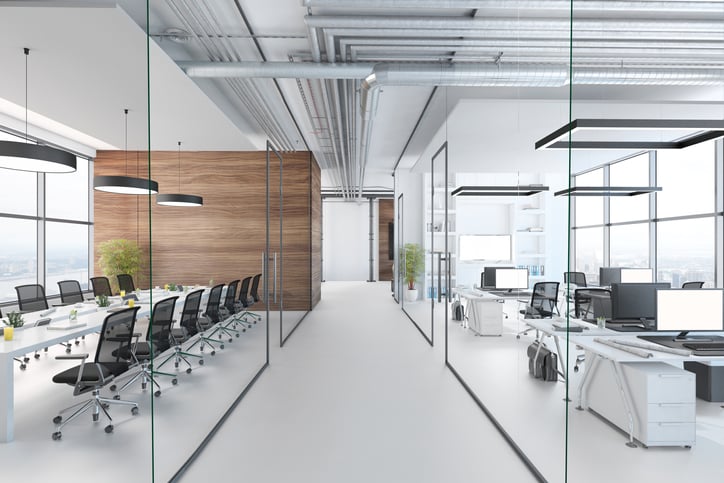Every business faces challenges that establish its unique security needs and objectives. Some organizations will focus on high-tech upgrades like biometric access control devices and visitor management systems. Others will focus on low-tech options like bulletproof glass. If you’re like most, you’ll be looking at a combination of both. To help you get organized, here are five things you should do before bulletproofing corporate offices.
1. Conduct a Security Site Assessment
Conducting a site assessment is the critical first step in improving your building security. The purpose of a site assessment is to create a holistic picture of security at your physical location(s), one that considers your risks, threats, and any gaps in current security. Based on those findings, you’ll get recommendations and an overall security plan. If that plan includes a ballistic barrier(s) your security expert will recommend an appropriate bulletproof glass level and placement, or work with a contractor who specializes in bulletproof installations.
Rick Reid, National Account Program Manager for TSS, is an advocate for site assessments for his customers:
“I highly recommend having a security site assessment conducted by an accredited professional. The American Society of Industrial Security (ASIS) is a great accrediting organization. ASIS is just one example, but I encourage you to do your research and seek professionals with CCP or PSP accreditation or proven site assessment experience and methodology.”
2. Get Stakeholders Aligned
Just like any other capital improvement, success depends on the alignment of objectives between all stakeholders. Bulletproof projects are no different.
This means coordinating:
- C-Suite
- Security personnel
- Architects
- Building owners
You should get everyone to review the site assessment findings to ensure that you’re choosing the best solutions for your people and your business.
3. Consider Bulletproof Glass Levels
Conversations about bulletproofing corporate offices usually start with the glass. Bullet-resistant glass comes in eight UL-Rated Ballistic Levels. There’s no one right answer for which level to choose, but it might help to know what’s commonly found in businesses and corporate headquarters.
For the past several years, we have typically installed UL 752, Levels 1-3 in office environments. UL 752 is the testing standard for “Bullet Resisting Equipment,” including bullet resistant acrylic, laminated glass, ballistic fiberglass, window framing, and doors.
But it’s not the de facto anymore says, Reid:
“We’re getting more requests for UL Levels 4 and 5. As a matter of fact, we’re working on a large project right now where the owner is requesting Level 4 on the exterior by back-glazing the entire lower level of the facility.”
Back-glazing means that they’re leaving the existing glazing in place and then putting a piece of UL-Rated Bullet-Resistant Glass Clad Polycarbonate (GCP) behind the exterior glazing.
This approach is often favored when there is a desire to maintain a uniform aesthetic for the building exterior. It is also less expensive than removing and replacing the existing glazing. GCP holds up well to most cleaning agents but building managers should still be aware of best practices for cleaning bulletproof glass to prevent crazing.
4. Choose Bulletproof Barrier Components
Most bulletproof barrier systems used in corporate settings consist of some combination of these components:
Reid confirms that barrier component choices depend on your security goals as well as aesthetics:
“C-Suite protection could mean all-glass bulletproof doors with a very high-end look to them. There might also be reinforced conference rooms with interior panic rooms. Whereas, a reception area might feature a full ballistic barrier with a work station inside and a single transaction window for communication. It just really depends on who is working in a particular area and how that area is being used.”
5. Communicate Thoughtfully to Employees
This is still a new frontier in corporate America. Not many businesses have the ‘corporate language’ to communicate why they’ve decided to add bulletproof glass or ballistic barriers.
While installing bulletproof elements is an investment in safety and creating peace of mind for employees, it can also stir up fears. We recommend getting your human resources, corporate communications team and the security expert you worked with on your site assessment together to draft clear, timely communication ahead of your bulletproof barrier installation.
Here are some talking points that we’ve seen our customers use effectively:
- We’re doing this because we care about the people who work here and their safety
- There has not been a direct threat to our company or individual employees, we are taking a proactive approach
- Bulletproof glass is a deterrent to violence or criminal behavior
- We’re investing in several safety improvements and this is just one of them
Reid agrees from experience that the key to success is putting people first:
“Any change you make, even something simple like replacing office furniture – it’s going to raise questions, possibly even anxiety. Something as significant as a bulletproof barrier installation requires clear communication and setting everyone’s expectations from the very beginning.”
The bottom line on preparing for success: do your research, avoid cookie-cutter solutions, and communicate clearly so everyone is on the same page.


